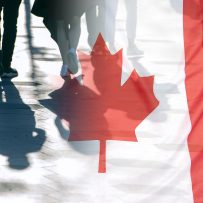CANADIAN TEMPORARY RESIDENT GROWTH FALLS 48%, LONG “OVERDUE”: BMO

Canada’s policymakers went from explaining that millions of temporary residents are needed, to cheering on the reversal of their policies over a few short months. Statistics Canada (Stat Can) data shows the flow of non-permanent (temporary) residents slowed in Q2 2024. After doubling in a couple of years, the temporary population remains robust but marks a stark shift in policy. Consequently, one of the country’s largest banks is telling investors to pay close attention, as it can mean big changes for the economy.
Canada’s Non-Permanent Resident Stimulus Plan Isn’t Working
Canada’s economy has long benefitted from robust immigration, so policymakers tried to double down. They scaled up immigration and used it as a form of economic stimulus. The idea was excess labor would lead to slower wage growth, reducing input costs, as well as generating more consumption. A key part of this plan is non-permanent (temporary) residents, which includes those on work visas, study permits, refugee applications, and “special permits.”
Stimulus overuse can quickly erode into a liability as it becomes more inefficient. It’s no surprise it occurred here, with the forced growth creating so much demand for essentials that it became inflationary, reducing consumption everywhere else. Rising unemployment is quickly become a major liability too, as policymakers sell foreign labor on jobs that domestic labor can’t find. The plan is now widely criticized, and it’s led to the aggressive tapering of immigration programs like those used by temporary residents.
Canada Saw A 47% Drop In Net Flow of Non-Permanent Residents
Canada’s non-permanent resident population growth is very abruptly slowing. The net flow fell to 118k people in Q2 2024, about 23.7% smaller than the previous quarter. It represents a whopping 46.8% drop from last year, and the smallest quarterly advance in six quarters. Despite being cut in half, you’re probably thinking 118k people is still a lot for a quarter. You aren’t alone.
Source: BMO; Statistics Canada.
“Canada’s (long overdue) movement to temper the number of nonpermanent resident (NPR) inflows is taking shape very slowly,” notes Robert Kavcic, a senior economist at BMO.
He reminds investors this is a sharp slowdown, but annualized this would still be 465k more non-permanent residents. When numbers get that big, it tends to lose meaning to most people. So if it helps, that number is larger than the population of Halifax. In other words, at this pace Canada would still be adding enough people to build a new Halifax on top of the existing program.
Kavcic adds, “While well down from recent highs, that was still adding more than a full percentage point to annual population growth.”
Canada’s Temporary Resident Population Doubled In Just 2 Years
Canada has always had a big immigrant population, so it’s hard to appreciate just how much things changed. The unadjusted non-resident population grew an estimated 4% to 3 million people in Q2 2024. Quarterly growth of the total non-resident population was the slowest in two years. However, back then, the country’s non-resident population was roughly 1.5 million, and it has nearly doubled since then.
Advancing at a pace greater than the general population is still huge growth. It’s just not the breakneck speed policymakers were pursuing, like the world would run out of temporary residents. The sudden shift is big enough that it can ease pressure on some of the bigger problems faced by the economy.
“We won’t go through the wide array of impacts this is having, yet again, in this space—think pressure on rents, service infrastructure and youth unemployment. Instead, keep an eye on this component going forward as measures to curb the inflow of international students and temporary foreign workers take hold,” Kavcic explains.
Canada Is Suddenly Scrambling To Slow Temporary Resident Growth
Canadian policymakers behind the initial plan are now scrambling to cut the growth. The Government of Canada (GoC) recently announced it would cut temporary resident permits by 20%, after doubling the amount. They also recently announced a pause on processing applications for “low wage” temporary foreign workers in some cities, and imposed a study permit limit (albeit after an application decline).
“Ottawa will also officially publish targets for NPR flows in their upcoming immigration levels plan (for the first time). If they are to meet the targets they have previously guided toward, we would expect to see net NPR flows turn negative in the years ahead,” explains Kavcic.
The growth remains substantial but marks a very big change for the narrative. Before the recent tapering, policymakers argued the volume of population growth was required for the economy. Now that the plan has proven chaotic at best, the narrative has shifted to the need to rapidly taper as if the public wasn’t told just months prior the opposite was needed.
Story by: Better Dwelling



